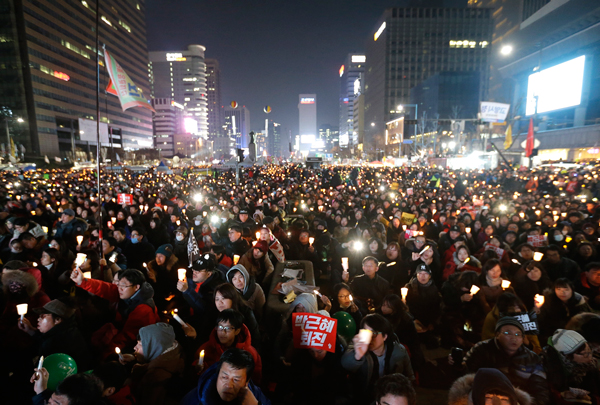President of South Korea Ousted After Months of Determined Protests
March 20, 2017 | Revolution Newspaper | revcom.us

People filled the streets of Seoul, South Korea, on December 3, 2016 to demand that South Korean President Park must get out of office. This was the sixth straight weekend of massive protests. Photo: AP
On March 10, in an unprecedented move in the country’s history, a South Korean court removed the president from office. This came after months of determined protests with millions of people taking to the streets all over the country, week after week, demanding that President Park Geun-hye resign in the face of a growing corruption scandal.
In December, Park had been stripped of her presidential powers after a legislative vote to impeach her. Now a constitutional court has unanimously decided that Park has committed “acts that violated the Constitution and laws” and must step down. As a civilian, Park no longer has presidential immunity and prosecutors are now seeking to charge her with bribery, extortion, and abuse of power. Hwang Kyo-ahn, an ally of Park, will serve as acting president until the country elects a new president, which it is required to do within 60 days.
Months of Determined Protests
Week after week, for many months, hundreds of thousands took to the streets in the capital city of Seoul and in other cities in South Korea. These protests were determined—expressing in words and deeds the stance that just because a regime is in power, it doesn’t have to stay in power—that just because someone is elected for a five-year term doesn’t mean they can’t be forced out before that.
These protests were initially sparked by a corruption scandal, centered on how Park let her friend Choi Soon-sil use the government to extort tens of millions of dollars from businesses. But all kinds of things about Park’s presidency have angered people and, as many analysts have noted, people were not just seeking to remove a leader but also rebelling against a dictatorial political order that had ruled in South Korea for decades.
Park Geun-hye’s father, Park Chung-hee, seized power in a military coup in 1961 and ruled as a brutal president and military general until he was assassinated in 1979. His is a hated legacy Park Geun-hye continued in her presidency.
Park attacked the labor movement, including the left-wing Korean Teachers and Educational Workers’ Union. She maintained a blacklist of cultural figures who spoke out against government policies or supported opposition politicians. In 2015, she announced that school textbooks produced by private publishers would be replaced with government-issued ones – which were full of not only factual errors, but right-wing bias. In April 2014, there was the tragic Sewol ferry disaster, where more than 300 people died, 250 of them high school students. Many looked at the callous way Park handled this as a concentration of how the president just didn’t care about the people. Together with all this, there was also widespread and deep dissatisfaction with persistent, deep inequalities in society in things like education and employment—which people felt Park was only reinforcing. Under these circumstances, powerful forces in the South Korean ruling class made a call that Park should go.
Celebrating Park’s Downfall
On Saturday, March 11, in Seoul, tens of thousands rallied to mark the downfall of Park—up against over 20,000 police. People were there to celebrate—but also to demand that Park be arrested and imprisoned. Someone had made a replica of a jail cell with cardboard cutouts of Park and others who had been implicated in the corruption scandal and people took turns taking selfies in front of it, while people snacked on a “prison bread” that had been specially packaged for the occasion. Some expressed anger that Park was still in the presidential Blue House. A 24-year-old protester, a web designer, said, “I want her dragged out because that’s what’s right.” A 37-year-old law school graduate carried a sign that said, “Park Geun-hye must immediately move out. The place she belongs is prison.” A former supporter of Park who had turned against her, a 73-year-old woman who came with her son and daughter-in-law, said, “I used to like Park Geun-hye, but I think I was mistaken. Young people know what’s happening now, but we old people were living in the past.”
For months, millions of people took to the streets, determined to keep protesting until Park was forced from office. At the massive evening demonstrations, they carried candles and began to call themselves the Candle Force. Now, as tens of thousands occupied the streets in downtown Seoul to celebrate their victory in bringing about the ouster of Park, they shouted, “The candles have won!”
Volunteers Needed... for revcom.us and Revolution
If you like this article, subscribe, donate to and sustain Revolution newspaper.
